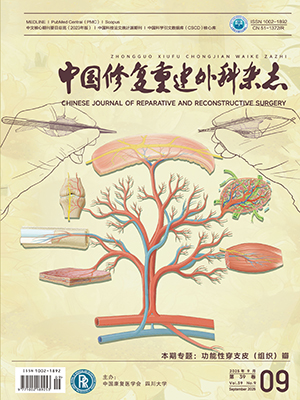| 1. |
Liu Z, Zhou C, Guo H, et al. Knowledge mapping of global status and trends for thromboangiitis obliterans: A bibliometrics and visual analysis. J Pain Res, 2023, 16: 4071-4087.
|
| 2. |
Gundogmus CA, Samadli V, Sorkun M, et al. The effect of smoking cessation on the technical success of endovascular treatment for thromboangiitis obliterans. J Vasc Interv Radiol, 2023, 34(6): 1038-1044.
|
| 3. |
Shimizu Y, Murohara T. Therapeutic angiogenesis for thromboangiitis obliterans. Circ J, 2023, 87(9): 1238-1239.
|
| 4. |
Ng KLB, Hsieh MW, Lin YN, et al. Application of nanofat grafting to rescue a severe ischaemic hand with thromboangiitis obliterans: A case report about promising salvage procedure. Medicine (Baltimore), 2021, 100(42): e27577. doi: 10.1097/MD.0000000000027577.
|
| 5. |
Raimbeau A, Pistorius MA, Goueffic Y, et al. Digital ischaemia aetiologies and mid-term follow-up: A cohort study of 323 patients. Medicine (Baltimore), 2021, 100(20): e25659. doi: 10.1097/MD.0000000000025659.
|
| 6. |
Salimi J, Cheraghali R, Omrani Z, et al. Surgical treatment options for Buerger’s disease (experience with 315 cases in Iran). Med J Islam Repub Iran, 2022, 36: 134. doi: 10.47176/mjiri.36.134.
|
| 7. |
Galyfos G, Liakopoulos D, Chamzin A, et al. A systematic review and meta-analysis of early and late outcomes after endovascular angioplasty among patients with thromboangiitis obliterans and chronic limb ischemia. J Vasc Surg, 2023, 77(5): 1534-1541.
|
| 8. |
徐道非, 胡蓉, 余庆龙, 等. 胫骨横向搬移技术的临床应用及其诱导血管再生机制的研究进展. 中华骨与关节外科杂志, 2023, 16(9): 854-859.
|
| 9. |
Shionoya S. Diagnostic criteria of Buerger’s disease. Int J Cardiol, 1998, 66 Suppl 1: S243-S245, S247.
|
| 10. |
Olin JW. Thromboangiitis obliterans (Buerger’s disease). N Engl J Med, 2000, 343(12): 864-869.
|
| 11. |
Patwa JJ, Krishnan A. Buerger’s disease (thromboangiitis obliterans)—Management by Ilizarov’s technique of horizontal distraction. A Retrospective Study of 60 Cases. Indian J Surg, 2011, 73(1): 40-47.
|
| 12. |
林世泓, 杨雄刚, 耿翔, 等. 胫骨横向骨搬移技术对糖尿病足的治疗作用及其生物学机制研究进展. 中国临床医学, 2023, 30(1): 12-17.
|
| 13. |
Liu Z, Xu C, Yu YK, et al. Twenty years development of tibial cortex transverse transport surgery in PR China. Orthop Surg, 2022, 14(6): 1034-1048.
|
| 14. |
常树森, 杨尉, 宋荷花, 等. 胫骨横向骨搬移技术联合改良神经松解术治疗糖尿病足溃疡. 中国修复重建外科杂志, 2023, 37(11): 1410-1417.
|
| 15. |
Ou S, Xu C, Yang Y, et al. Transverse tibial bone transport enhances distraction osteogenesis and vascularization in the treatment of diabetic foot. Orthop Surg, 2022, 14(9): 2170-2179.
|
| 16. |
Yang Y, Li Y, Pan Q, et al. Tibial cortex transverse transport accelerates wound healing via enhanced angiogenesis and immunomodulation. Bone Joint Res, 2022, 11(4): 189-199.
|
| 17. |
Tian W, Feng B, Zhang L, et al. Tibial transverse transport induces mobilization of endothelial progenitor cells to accelerate angiogenesis and ulcer wound healing through the VEGFA/CXCL12 pathway. Biochem Biophys Res Commun, 2024, 709: 149853. doi: 10.1016/j.bbrc.2024.149853.
|
| 18. |
Kong LC, Li HA, Kang QL, et al. An update to the advances in understanding distraction histogenesis: From biological mechanisms to novel clinical applications. J Orthop Translat, 2020, 25: 3-10.
|
| 19. |
Zou C, Liu L, Huang C, et al. Baiying qingmai formulation ameliorates thromboangiitis obliterans by inhibiting HMGB1/RAGE/NF-κB signaling pathways. Front Pharmacol, 2022, 13: 1018438. doi: 10.3389/fphar.2022.1018438.
|
| 20. |
Liu C, Kong X, Wu X, et al. Alleviation of A disintegrin and metalloprotease 10 (ADAM10) on thromboangiitis obliterans involves the HMGB1/RAGE/ NF-κB pathway. Biochem Biophys Res Commun, 2018, 505(1): 282-289.
|
| 21. |
Fazeli B, Ligi D, Keramat S, et al. Recent updates and advances in Winiwarter-Buerger Disease (thromboangiitis obliterans): Biomolecular mechanisms, diagnostics and clinical consequences. Diagnostics (Basel), 2021, 11(10): 1736. doi: 10.3390/diagnos-tics11101736.
|
| 22. |
Zhao L, Lei Y, Pang M, et al. An improved bone transport surgical method for treating chronic ischemic ulcers (thromboangiitis obliterans). Front Surg, 2022, 9: 859201. doi: 10.3389/fsurg.2022.859201.
|
| 23. |
Qi Y, Xu C, Wu X, et al. Thromboangiitis obliterans successfully treated with radius transverse transport. Asian J Surg, 2022, 45(12): 2808-2809.
|




